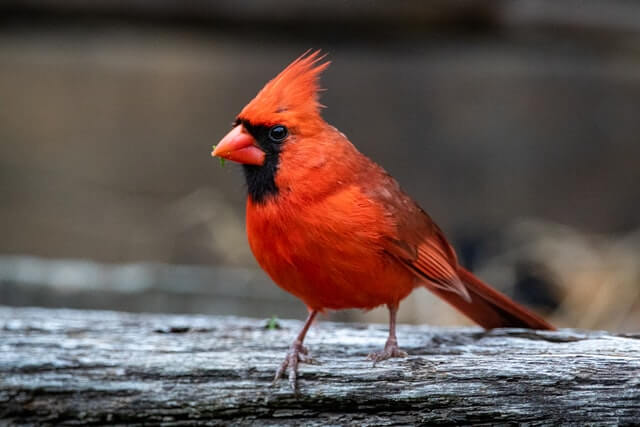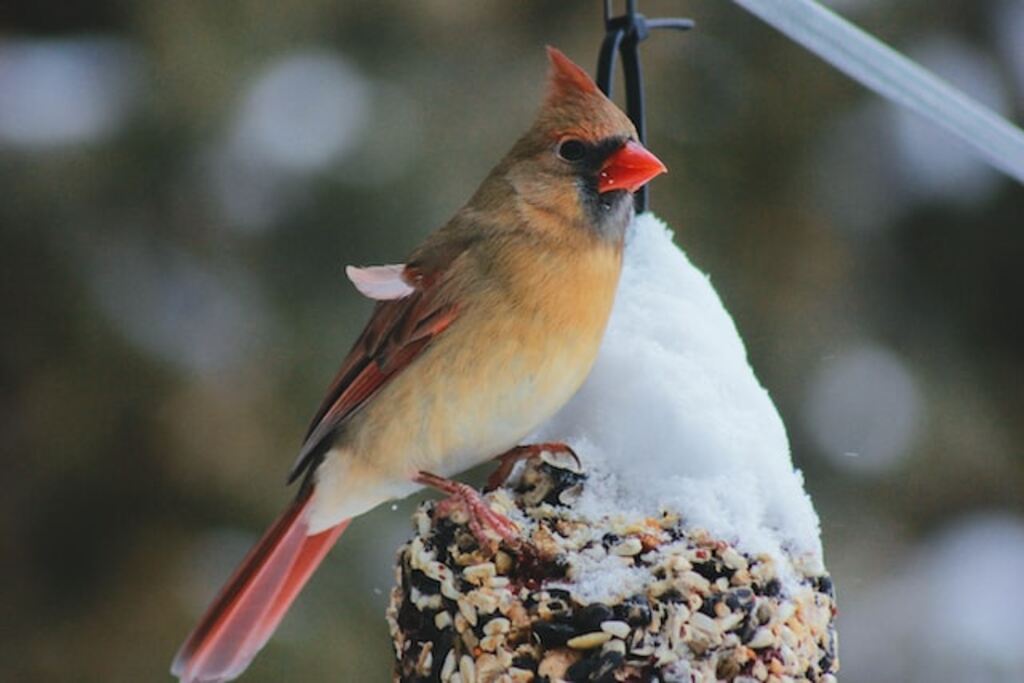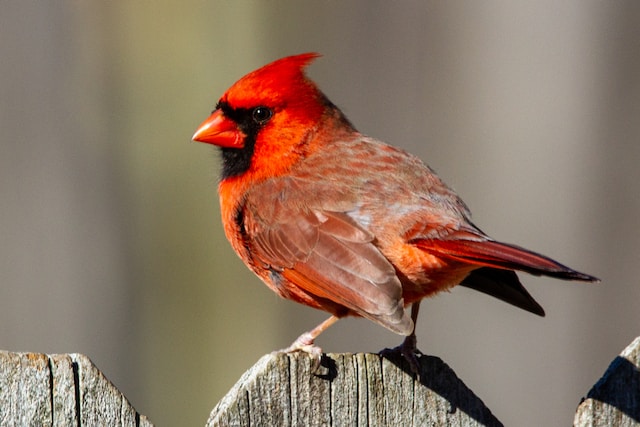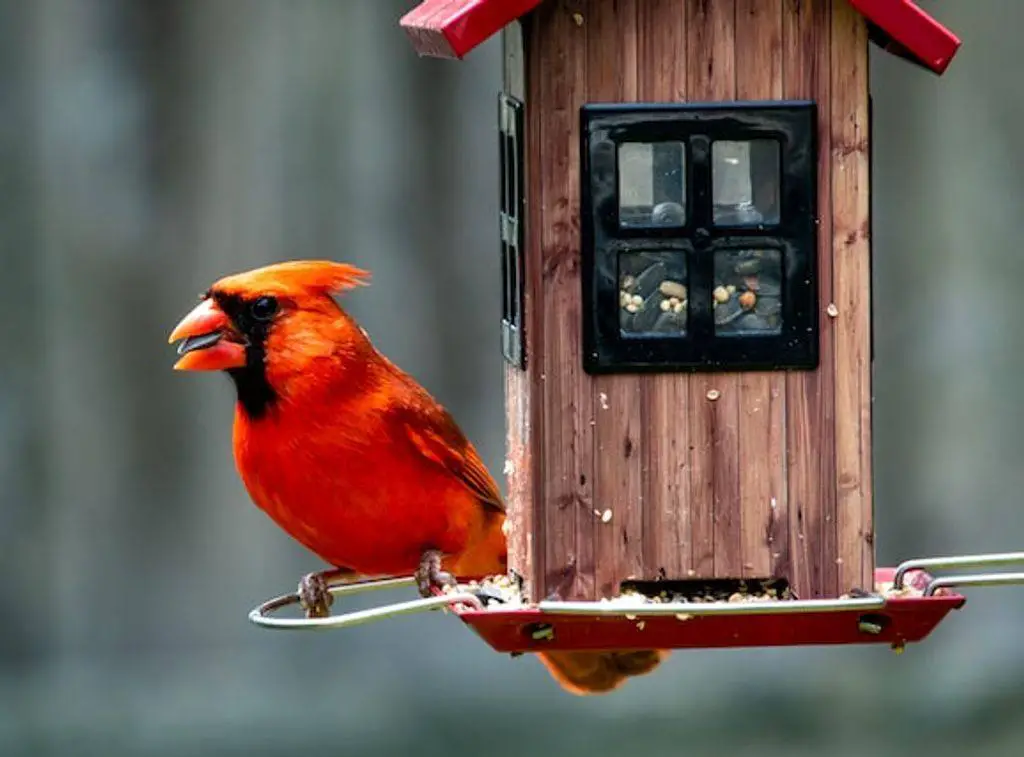When it comes to avian symbols of state pride, few are as beloved as the Northern Cardinal, which has been the official state bird of Illinois since 1929. But why was this particular bird chosen to represent the state, and what makes it such a cherished icon among Illinoisans?
In this article, we’ll explore the fascinating history and unique characteristics of the Northern Cardinal, and discover why it continues to capture the hearts of birdwatchers and nature enthusiasts alike.
Table of Contents
- 1 Illinois State Bird: The Northern Cardinal
- 1.1 History
- 1.2 The Cultural Significance of the Northern Cardinal
- 1.3 The Northern Cardinal: Appearance
- 1.4 Physical Description
- 1.5 Coloration
- 1.6 Distinguishing Features
- 1.7 Differences between Male and Female
- 1.8 Behavior
- 1.9 Range
- 1.10 Habitat
- 1.11 Cardinal’s Mating Habits and Nesting Behavior
- 1.12 Migratory Patterns and Other Adaptations
- 1.13 Threats and Conservation
- 1.14 Conservation of the Illinois State Bird
- 2 How to Attract Northern Cardinals to your Yard?
- 3 Tips for Spotting and Photographing the Northern Cardinal
- 4 FAQs About the Illinois State Bird
- 4.1 What is the scientific name for the Northern Cardinal?
- 4.2 What is the average lifespan of a Northern Cardinal?
- 4.3 Why was the Northern Cardinal chosen as the state bird of Illinois?
- 4.4 What is the habitat of the Northern Cardinal in Illinois?
- 4.5 What is the diet of the Northern Cardinal?
- 4.6 Are Northern Cardinals monogamous?
- 4.7 How do Northern Cardinals communicate?
- 4.8 Are Northern Cardinals migratory birds?
- 4.9 What are the biggest threats to the Northern Cardinal in Illinois?
- 4.10 What can I do to help protect the Northern Cardinal in Illinois?
- 4.11 Do male and female Northern Cardinals look different?
- 4.12 What is the nesting behavior of Northern Cardinals?
- 4.13 What adaptations do Northern Cardinals have?
- 5 Conclusion
- 6 Author
Illinois State Bird: The Northern Cardinal
History
The Northern Cardinal has a long and rich history in the state of Illinois. The first recorded sighting of the bird in Illinois was in 1785 by explorer John Mitchell. However, it wasn’t until the late 1800s that the Northern Cardinal began to capture the attention of Illinois residents, who were struck by the bird’s vivid red plumage and melodious song.
By the early 1900s, the Northern Cardinal had become a beloved symbol of the state, with its image appearing on everything from postcards to murals. In 1929, the Illinois General Assembly officially designated the Northern Cardinal as the state bird of Illinois, cementing its status as an iconic symbol of the state.
Over the years, the Northern Cardinal has continued to inspire artists, writers, and bird enthusiasts in Illinois and beyond. Its image has been featured in numerous poems, songs, and stories, and it has become one of the most recognizable and beloved birds in the United States.
Table: History of the Northern Cardinal in Illinois
| Date | Event |
|---|---|
| Late 1800s | Northern Cardinal first observed in Illinois |
| 1929 | Northern Cardinal designated as Illinois State Bird |
| 1983 | Illinois State Legislature designates the Northern Cardinal as the official state bird of Illinois |
| Present day | The Northern Cardinal remains a beloved cultural symbol of Illinois, featuring prominently in art, literature, and popular culture |
This table provides a concise and informative summary of the history of the Northern Cardinal in Illinois, including its arrival in the state, its designation as the state bird, and its ongoing cultural significance.
The Cultural Significance of the Northern Cardinal
The Northern Cardinal’s role as a cultural icon in Illinois is rooted in its natural beauty, melodious song, and long history in the state. The bird’s striking red plumage and sweet song have captured the hearts of Illinois residents for generations, and its image has been used to promote everything from tourism to conservation efforts.
In addition to its natural beauty, the Northern Cardinal has played an important role in Illinois art and literature. Its image can be found in a wide range of artistic mediums, including paintings, sculptures, and photographs.
It has also been featured in numerous poems, songs, and stories, including the classic children’s book “The Big Red Cardinal” by Illinois author Mabel Powers.
The Northern Cardinal’s enduring popularity as a cultural symbol is a testament to its enduring appeal and its close association with the natural beauty and rich cultural heritage of Illinois.
The Northern Cardinal: Appearance


| Northern Cardinal | Male | Female |
|---|---|---|
| Average Length | 8.3 inches (21 cm) | 8.3 inches (21 cm) |
| Wingspan | 9.8-12.2 inches (25-31 cm) | 9.8-12.2 inches (25-31 cm) |
| Weight | 1.5-1.7 oz (42-48 g) | 1.5-1.7 oz (42-48 g) |
| Crest | Red | Red tint |
| Body Coloration | Red | Brown or Gray |
| Face Mask | Black | Black |
| Bill Color | Thick, orange-red | Thick, orange-red |
| Tail Length | Longer | Shorter |
This table provides a clear and concise comparison between male and female Northern Cardinals, highlighting their physical differences in size and coloration.
Physical Description
The Northern Cardinal (Cardinalis cardinalis) is a small to medium-sized bird, with an average length of 8.3 inches (21 cm) and a wingspan of 9.8-12.2 inches (25-31 cm). It has a distinctive crest on its head, a short thick bill, and a long tail. The bird’s weight ranges from 1.5-1.7 oz (42-48 g).
Coloration
The Northern Cardinal is known for its bright red coloration, which is most prominent on the male birds. The males have a red crest on their head, a red body, and a black face mask. The females, on the other hand, have a red tint on their crest, wings, and tail, but are mostly brown or gray in color. Both males and females have a prominent black patch on their face and a thick, orange-red bill.
Distinguishing Features
One of the most distinguishing features of the Northern Cardinal is its crest, which it can raise and lower depending on its mood. The bird’s stout bill is also a prominent feature, allowing it to crack open seeds and nuts with ease. Additionally, the Northern Cardinal has a distinctive chirp that is easily recognizable.
Differences between Male and Female
While both male and female Northern Cardinals share many physical characteristics, there are a few key differences. As mentioned earlier, male Northern Cardinals have a more vibrant red coloration, while females are mostly brown or gray. Male Northern Cardinals also have a larger crest and a longer tail than females. Finally, the males have a thicker bill, which is used to attract females during courtship.

Behavior
Overview: Northern Cardinals are known for their lively and active behavior, making them a fascinating species to observe. In this section, we will discuss their mating habits, territorial behavior, and feeding habits, as well as how their behavior changes throughout the year.
Mating Habits: Male Northern Cardinals are known for their vivid red coloration, which they use to attract mates. They sing and perform courtship displays to impress females, who are attracted to their bright plumage and energetic behavior. Once a pair has formed, they work together to build a nest and care for their young.
Territorial Behavior: Northern Cardinals are fiercely territorial and will defend their territory against intruders. This behavior is most pronounced during the breeding season, when males will aggressively defend their nesting site against other males. They will use a variety of displays, including vocalizations, posturing, and physical attacks, to drive off rivals.
Feeding Habits: Northern Cardinals are primarily granivores, feeding on seeds and fruits. They will also eat insects and other small invertebrates, particularly during the breeding season, when protein is needed for egg production and feeding their young. They are frequent visitors to backyard bird feeders, where they will readily consume sunflower seeds, safflower seeds, and other types of seed mixes.
Seasonal Behavior: The behavior of Northern Cardinals changes throughout the year, reflecting the different stages of their life cycle. During the breeding season, they are focused on courtship, nesting, and raising their young. In the fall, they begin to form flocks and may migrate south to warmer climates. In the winter, they are more solitary and may rely heavily on backyard bird feeders for food.
Table: Northern Cardinal Feeding Habits
| Type of Food | Examples |
|---|---|
| Seeds | Sunflower seeds, safflower seeds, millet, corn |
| Fruits | Berries, cherries, grapes, oranges |
| Insects | Beetles, caterpillars, spiders, ants |

Range
The Northern Cardinal has long been a beloved part of the Illinois landscape, and its habitat and range are quite expansive. These birds can be found in a number of different habitats, including woodlands, thickets, gardens, and even suburban backyards.
They are most common in the southeastern United States, but their range stretches north to the Canadian border and west to the Mississippi River. Cardinals are also found in Mexico and parts of Central America.
Habitat
Northern Cardinals are versatile birds that can thrive in a variety of habitats throughout Illinois. Here are some of the common types of habitats where you can find them:
Forests
- Cardinals are known to nest and forage in forested areas, particularly deciduous forests with a mix of trees and shrubs.
- They prefer to be near the edge of the forest, where they can easily fly out to open areas to find food.
- Cardinals are also found in forested urban areas, such as city parks or tree-lined residential neighborhoods.
Backyards
- One of the most common places to spot Northern Cardinals is in your own backyard.
- Cardinals are attracted to bird feeders and bird baths, and will often visit these areas for food and water.
- They are also known to nest in shrubs and bushes around residential areas.
Parks and other open areas
- Cardinals can also be found in open areas such as parks, fields, and meadows.
- They prefer areas with plenty of shrubs and bushes for nesting and cover, but will venture out into open areas to find food.
Habitat conservation is crucial for the survival of the Northern Cardinal species. This can be done by preserving and restoring natural habitats, reducing pesticide use, and creating bird-friendly habitats in urban areas. By protecting the habitats of Northern Cardinals, we can ensure that these beautiful birds continue to thrive in Illinois for years to come.
Table: Common habitats of Northern Cardinals in Illinois
| Habitat | Description |
|---|---|
| Deciduous forests | Cardinals nest and forage in these forested areas |
| Urban areas | Cardinals can be found in tree-lined neighborhoods |
| Backyards | Cardinals are attracted to bird feeders and bird baths |
| Parks and open areas | Cardinals will venture out into open areas to find food |
Cardinal’s Mating Habits and Nesting Behavior
The Northern Cardinal is an iconic species of the state of Illinois and has some interesting mating habits and nesting behaviors. This species typically forms monogamous pairs, with both parents working together to build the nest and feed the young.
The male will gather materials for the nest and the female will construct it. The nest is usually a cup-shaped structure made of twigs and grass and lined with finer materials such as feathers or fur. The female will lay between 3 and 4 eggs, which both parents will incubate.
The chicks will hatch after 11 to 13 days and will fledge the nest after 10 to 12 days. Both parents will feed and take care of the chicks until they are able to leave the nest and become independent.
The Northern Cardinal is an important species in the state of Illinois, and their fascinating mating and nesting behaviors provide more insight into the species.
| Aspect | Description |
|---|---|
| Mating system | Monogamous |
| Nest building | Both parents contribute; male gathers materials, female constructs nest |
| Nest structure | Cup-shaped structure made of twigs and grass, lined with finer materials such as feathers or fur |
| Clutch size | 3 to 4 eggs |
| Incubation period | 11 to 13 days |
| Nestling period | 10 to 12 days |
| Parental care | Both parents feed and take care of the chicks until they are able to leave the nest and become independent |

Migratory Patterns and Other Adaptations
The Northern Cardinal is an impressive species, not only for its iconic appearance, but also for its amazing adaptations. This state bird of Illinois is known to be a non-migratory species, which means they typically stick to the same area year-round.
However, they are known to make short-distance migrations in colder months in search of food sources. Cardinals have also adapted to a variety of habitats, from woodlands to gardens, and even to urban areas.
They have an amazing ability to find food even in the dead of winter, which is why they are so successful in harsh climates.
The Northern Cardinal is also capable of adapting to human presence, which is why many people enjoy seeing them in their gardens.
| Trait | Description |
|---|---|
| Migratory patterns | Non-migratory species, but may make short-distance migrations in colder months |
| Habitat adaptations | Adaptable to a variety of habitats, including woodlands, gardens, and urban areas |
| Food-finding ability | Amazing ability to find food even in harsh winter climates, making them successful in cold environments |
| Adaptation to humans | Capable of adapting to human presence, making them a common sight in gardens and urban areas |
The Northern Cardinal’s impressive adaptations and ability to thrive in a range of environments have made it an important and beloved species in the state of Illinois.
Threats and Conservation
The Northern Cardinal is a bird species that faces several threats to its survival. Some of the significant threats are:
- Habitat Loss: With the expanding urbanization and agricultural activities in Illinois, the Northern Cardinal’s natural habitat is under constant threat of being destroyed or altered. As a result, the bird’s breeding grounds and food sources are at risk of being lost or degraded.
- Climate Change: The changing climate patterns are affecting the Northern Cardinal’s habitat and migration patterns, leading to the loss of suitable breeding grounds and food sources.
Conservation efforts are crucial to protect the Northern Cardinal and its habitat in Illinois. Some of the current conservation initiatives comprise:
- Habitat Protection: Several organizations are working to protect the Northern Cardinal’s natural habitat in Illinois by creating protected areas and restoring degraded habitats. This helps to preserve the bird’s breeding grounds and food sources.
- Public Awareness: Educating the public about the Northern Cardinal’s importance and the threats it faces can help raise awareness and encourage conservation efforts.
- Research: Ongoing research helps to better understand the Northern Cardinal’s behavior and ecology, which can lead to improved conservation strategies.
Conservation of the Illinois State Bird
As the official state bird of Illinois, the Northern Cardinal is an important part of the state’s natural heritage. Unfortunately, its habitat is increasingly threatened by habitat destruction and degradation.
To ensure that future generations can enjoy its bright colors and melodic chirps, it is important to promote the conservation of the species and its habitats.
This can be done in several ways, such as planting native plants that provide food and shelter for the Cardinal, avoiding the use of pesticides and other harmful chemicals, and supporting organizations that are dedicated to researching and protecting the species.
By taking these steps, we can help ensure that the Northern Cardinal will remain an important part of Illinois’ natural landscape for generations to come.
How to Attract Northern Cardinals to your Yard?
If you want to attract these stunning birds to your yard, here are some tips that may help:
- Provide food: Northern Cardinals are seed-eating birds, so you can attract them by offering seeds in bird feeders. They prefer black oil sunflower seeds, but also enjoy safflower, millet, and other seeds. Make sure to keep your feeders clean and filled with fresh seeds.
- Offer water: Cardinals also need water to drink and bathe in, so having a bird bath or shallow dish of water can attract them to your yard. To maintain cleanliness and freshness, make sure to replace the water on a regular basis.
- Create habitat: Northern Cardinals prefer habitats with dense vegetation, so planting bushes, shrubs, and trees in your yard can provide them with shelter and nesting sites. They also like to forage on the ground, so leaving some fallen leaves or providing a ground feeder can be beneficial.
- Avoid pesticides: Pesticides can harm birds, so try to avoid using them in your yard. Instead, use natural pest control methods or plant pest-resistant plants.
- Be patient: It may take some time for Northern Cardinals to discover your yard, so be patient and consistent with your efforts. Once they do find your yard, they may become regular visitors.
By following these tips, you can create a welcoming environment for Northern Cardinals and enjoy their beautiful presence in your yard.
| Attraction Factor | How to Provide |
|---|---|
| Food | Offer black oil sunflower seeds, safflower seeds, cracked corn, and peanuts in a hopper or platform feeder. Northern Cardinals also enjoy fruit, such as sliced apples or oranges. |
| Water | Provide a shallow bird bath or water feature with a gentle trickle of water. |
| Shelter | Plant dense shrubs and bushes for nesting and roosting. Northern Cardinals also appreciate evergreen trees and brush piles for shelter. |
| Nesting Materials | Leave out small twigs, grasses, and other natural materials in a designated area for the Northern Cardinals to use for building their nests. |
| Predators | Install a predator guard on your bird feeder to prevent squirrels and other animals from stealing food. Additionally, keeping outdoor pets indoors or leashed can prevent them from harming the Northern Cardinals. |

Tips for Spotting and Photographing the Northern Cardinal
Spotting and photographing the Northern Cardinal is a great way to appreciate and enjoy this beautiful species. The vibrant red feathers of the male Cardinal make it easy to spot, even from a distance. Cardinals are also quite active, so they can often be found foraging or singing in the open areas.
If you’re looking for a unique photo opportunity, try to find a spot near a bird feeder, as Cardinals love a variety of seeds. To capture the perfect shot, use a telephoto lens, set your camera to a high shutter speed and make sure the light is behind you.
If you find yourself in a wooded area, keep an eye out for Cardinals that are nesting or roosting in the trees. With a bit of patience and some luck, you can capture a stunning photograph of the beloved Illinois State Bird.
FAQs About the Illinois State Bird
What is the scientific name for the Northern Cardinal?
The Northern Cardinal is known scientifically as Cardinalis cardinalis and belongs to the Cardinalidae family.
What is the average lifespan of a Northern Cardinal?
The average lifespan of a Northern Cardinal in the wild is around 3 years, but they can live up to 15 years in captivity.
Why was the Northern Cardinal chosen as the state bird of Illinois?
The Northern Cardinal was chosen as the state bird of Illinois in 1929 due to its abundance in the state, its bright red color, and its pleasing song.
What is the habitat of the Northern Cardinal in Illinois?
The Northern Cardinal can be found in a variety of habitats in Illinois, including woodlands, forests, suburban areas, and even urban parks and gardens.
What is the diet of the Northern Cardinal?
The Northern Cardinal primarily feeds on seeds, fruits, and insects. They also occasionally eat snails, small lizards, and spiders.
Are Northern Cardinals monogamous?
Yes, Northern Cardinals are monogamous and typically mate for life. They may stay with their mate year-round or only during breeding season.
How do Northern Cardinals communicate?
Northern Cardinals communicate using a variety of vocalizations, including songs, calls, and whistles. They also use body language, such as head-bobbing and tail-flicking.
Are Northern Cardinals migratory birds?
Some Northern Cardinals are migratory, while others are year-round residents. Those that live in the northern part of their range may migrate south for the winter.
What are the biggest threats to the Northern Cardinal in Illinois?
The biggest threats to the Northern Cardinal in Illinois include habitat loss due to urbanization and agriculture, as well as climate change and predation by domestic cats.
What can I do to help protect the Northern Cardinal in Illinois?
You can help protect the Northern Cardinal in Illinois by providing habitat through planting native plants, keeping cats indoors, supporting conservation efforts, and spreading awareness about the importance of protecting this species.
Do male and female Northern Cardinals look different?
Yes, male and female Northern Cardinals have distinct differences in their appearance. Males are bright red with a black face and bill, while females are a duller brown with a reddish tint and a red bill.
What is the nesting behavior of Northern Cardinals?
Northern Cardinals are monogamous, and both parents work together to build the nest, incubate the eggs, and feed the young. The nest is usually a cup-shaped structure made of twigs and grass and lined with finer materials such as feathers or fur.
What adaptations do Northern Cardinals have?
Northern Cardinals have adapted to a variety of habitats and are capable of finding food even in harsh winter climates. They are also able to adapt to human presence, making them a popular bird to see in gardens and urban areas.
Conclusion
In conclusion, the Northern Cardinal is a stunning and iconic bird that plays an essential role in Illinois’s culture and environment. This article has provided a detailed overview of the bird’s physical appearance, behavior, habitat, history, threats, and conservation efforts.
As a state symbol, it is important to recognize the Northern Cardinal’s significance and take action to protect its habitat and ensure its survival. By doing so, we can ensure that future generations will be able to enjoy this beautiful bird and all that it represents.
Related Post:



